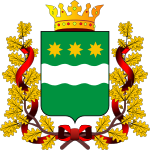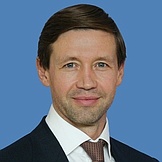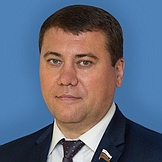Regional flags and emblems


PROFILE
Established 20 October 1932
Capital Blagoveshchensk
The Amur Region is part of the Far Eastern Federal District
Area 361,900 sq km
Population 750 900 (2025)
Ethnic groups
(2020 National Census, %)
Russian – 95,17
Other – 4,83
Administrative divisions (2024)
Municipal areas – 7
Municipal districts – 13
City districts – 9
Rural towns – 6
Rural districts – 77
Geography and climate
The region is in the southern Far East. The Stanovy Range is in the north. The Yankan, Tukuringra, Soktakhan and Dazhgdy mountain chains extend southwards. The Amur-Bureya and Amur-Zeya plains cover two-fifths of the total area.
The Amur Region borders on the Sakha (Yakutia) Republic, the Khabarovsk and Trans-Baikal territories and the Jewish Autonomous Region. It also has a state border with China.
The main rivers are the Amur and its tributaries, the Zeya and its tributaries, and the Bureya. On the Zeya River, there is the Zeya Reservoir.
The climate is continental with a monsoon touch. January temperatures average – 29.4°C. July temperatures average +19.1°C. Mean precipitation in January is 7 mm, and in July, 166 mm.
There are three state nature reserves: the Zeya, Nora, and Khingan nature reserves.
Government
The legislative branch is represented by the Amur Region Legislative Assembly, which is a permanent, representative and only legislative body of authority in the region.
The Amur Region Legislative Assembly has 27 deputies, with 18 of them running in single-mandate constituencies and the other 9 in the single electoral district under the proportional representation system.
The current Legislative Assembly was elected in September 2021. Its term expires in September 2026.
The system of executive bodies of the region includes the Governor of the Amur Region, the Government of the Amur Region, and other bodies of executive authority.
The Government of the Amur Region is the permanent supreme collegial body of executive authority. The Governor of the Amur Region forms the Government of the region and heads it.
The Governor of the Amur Region is the region's highest-ranking official, who heads the Government of the Amur Region and runs the executive branch. He is elected for five years by Russian citizens who permanently reside in the region. The term of the incumbent Governor expires in September 2028.
Economy and natural resources
Industrial production accounts for more than 20% of the regional GDP. The manufacturing sector is represented by the non-ferrous metal industry, mechanical engineering and metal processing, the timber and wood processing industries, and the food industry. Built for developing the country’s space industry, the Vostochny Space Launch Centre plays a major role in developing the city of Tsiolkovsky. The SLC has provided much not only for space-related infrastructure, but also for housing renovation and construction of the new ones, schools, kindergartens and development of other social infrastructure.
Mineral production is based on the prospected deposits of coal, gold, iron ore, titanium, vanadium, limestone, quartz sandstone, copper, nickel, tungsten, molybdenum, zinc, lead, tin, platinum, zeolite, antimony, graphite, talcum, raw materials for the construction industry and mineral waters. The Amursky Ugol (Amur Coal) company is the region's top brown and hard coal extractor. Gold mining remains one of the most vibrant sectors for the region. The Amur Region is Russia's third largest gold-mining centre. The leading gold-mining companies are Pokrovsky Rudnik, Albynsky Rudnik, Malomyrsky Rudnik, Berezitovy Rudnik, Priisk Solovyovsky.
The production and distribution of electricity, gas and water is based on an energy complex that includes thermal power stations, combined heat and power stations (Blagoveshchensk Thermal Power Station, Raychikhinsk Thermal Power Station) and hydroelectric power stations (Zeya Hydroelectric Power Station and Bureya Hydroelectric Power Station).
Agricultural production accounts for more than 4% of the regional GDP. The local climate makes it possible to produce grain crops (wheat, oat and barley), soy, buckwheat, potatoes, vegetables, and forage crops. The region is Russia's leading soybean producer. Also widespread are beef cattle breeding and dairy farming, pig breeding, poultry farming and apiculture, as well as deer breeding in the north.
Major food-making companies are: Blagoveshchensky Milk Factory, Amurskiy Oil-Extraction Plant, Amursky Broiler, AmurAgroTsentr, Zeya Blagoveshchensk Confectionery Factory, Oktyabrsky Elevator, Agrofirma ANK.
The Trans-Siberian Railway connects the Amur Region to sea ports in the Primorye Territory: Vladivostok, Nakhodka and Port Vostochny. The Far Eastern Railway (Baikal-Amur Railway) links the region to sea ports in the Khabarovsk Territory: Vanino and Sovetskaya Gavan. These two railways are interlinked by the BAM-Tynda railway, which increases their carriage capacity.
Culture and tourism
The region has vast cultural potential, rich traditions and a highly-developed network of cultural institutions. There are 450 cultural institutions, including three theatres, a regional philharmonic society, a regional history museum with affiliates, and around 80 public and departmental museums. There are more than 600 state-protected historical and cultural heritage sites.
Blagoveshchensk has many historical monuments, among them, one commemorating the signing of the Treaty of Aigun (the monument was restored in 1973), as well as an old church (a former Catholic church of the early 20th century). A Chinese influence is noticeable, given the geographical proximity to China. Many public places have Chinese names and there is a small toy town in Chinese style on the Novotroitskoye motorway.
History lovers will be thrilled to visit the so-called dinosaur cemetery near Kundur. More than a thousand dinosaur bones, including of the earlier unknown dinosaur species, were found there during the construction of a road in the 1990s. Other historical attractions are the Amur petroglyphs, which are almost 10,000 years old. These rock paintings are thought to have adorned ancient ceremonial sites, where people conducted religious rites and rituals connected with hunting, or family.
The region has many nature reserves that are home to rare animal and bird species. In the Nora Nature Reserve, between the Selemdzha and Nora rivers, one can find the Far Eastern stork, the black stork, the white-tailed eagle, the hooded crane, the Japanese crane and other rare birds.
In the Shimanovsk area, there is a unique geomorphic formation, the so-called Burning Mountains. Beneath the ground, there are brown coal deposits where spontaneous combustion occurred many years ago. Smoke rises above the surface, creating the “fire” effect.
The Amur Region is an ideal place for lovers of hunting and fishing. Local forests are home to brown and black bears, wild boars, hares, elks and many other animals. Local rivers are full of Amur sturgeon, white Amur (Chinese carp), rockling, silver carp and other fish species.
_________________________________________________________________


